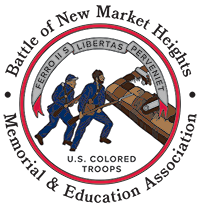A little known source from a white officer in the United States Colored Troops is the memoir written by Capt. (Brevet Maj.) John McMurray, Company D, 6th  United States Colored Infantry. I just recently found out that Recollections of a Colored Troop is available in digital scan version through the Library of Congress.
United States Colored Infantry. I just recently found out that Recollections of a Colored Troop is available in digital scan version through the Library of Congress.
A teacher before the war, McMurray originally served in the 135th Pennsylvania Infantry, a nine-month regiment, attaining a lieutenancy. However, when the 135th mustered out in May 1863, McMurray was in a sort of limbo until he learned about the formation of the United States Colored Troops and applied for a commission. After clearing the USCT screening process, McMurray received a captaincy with Company D, 6th United States Colored Infantry, which was organizing and training at Camp William Penn, near Philadelphia.
In Recollections of a Colored Troop, McMurray shares his memories of his times in camp, on the march, and on the battlefield. It is interesting to read his mentions of specific enlisted men, and then checking their service records. For example, in chapter 14, McMurray mentions William Law, a seemingly model soldier, who at 21 years old and standing at 6 foot 1 inches, served as a color bearer. Yet, in the regiment’s first true action at Baylor’s Farm, June 15, 1864, just outside Petersburg’s defenses, Law was not up to the demanding task. After being turned around by McMurray twice to face the enemy, Law threw down the colors and crawled to the rear. Law’s service records show that he became sick on June 21. He remained absent sick over the next several months and died of chronic dysentery on October 27, 1864. One has to wonder if his illness had affected his courage a few days earlier.
Another man, Pvt. Emanuel (aka Manual) Patterson, met his fate at the Battle of New Market Heights on September 29, 1864. Patterson had complained to McMurray about feeling unwell before being transported to Deep Bottom, but the surgeon dismissed Patterson’s complaint. Still feeling unwell the morning of the 29, McMurray took Patterson to see the surgeon again. Once more the doctor said Patterson was fine. Patterson assumed his position in line and participated in the attack. As McMurray remembered, “As I was pushing on through the slashing I met him suddenly, presenting one of the most terrible spectacles I ever beheld. He was shot in the abdomen, so that all of his bowels gushed out, forming a mass larger than my hat, seemingly, which he was holding up with his clasped hands to keep them from falling at his feet. Then, and a hundred times since, I wished I had taken the responsibility of saying to him he could remain at the rear.”

Pvt. Patterson’s death record
McMurray’s memories of the Battle of New Market Heights vividly describe the horrors of that fight. His Company D was left with only three men not killed, wounded or missing when all was said and done on September 29.
McMurray’s recollections also include thoughts on the Wilmington Campaign, hearing of the Confederate surrenders, eventual mustering out in the fall of 1865, and traveling back home to Brookville, Pennsylvania.
Recollections of a Colored Troop is an underappreciated but certainly valuable source.

